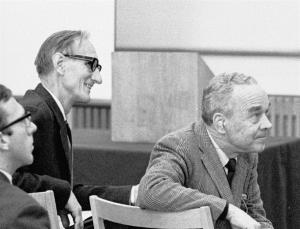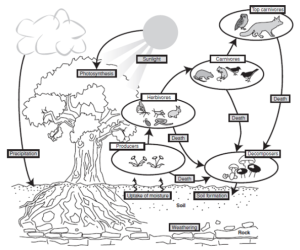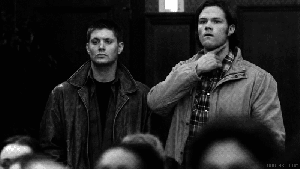
James Gibson and Gunnar Johansson. Image hosted on Spoonfiles, through Thomas Hard af Segerstad from Uppsala University

Gregory Bateson. Image hosted on Square One Explorations.
Some Key Terms to Remember:
Affordance – is part of the relationship between the environment and animal that can be found through “the terrain, shelters, water, fire, objects, tools, other animals, and human displays,” but it “must be measured relative to the animal” as it is what the environment “offers the animal, what it provides, or furnishes, either for good or ill” (Gibson, “Theory of Affordances” 127). This is Gibson word from the kinds of support that the environment (artificial or natural, though the two should not be considered separate from one another) offers for each species.
Objects (attached and detached) can also offer animals (humans included) affordances, but what they offer is often “extremely various;” “detached objects must be comparable in size to the animal under consideration if they are to afford behavior. But those that are comparable afford an astonishing variety of behaviors, especially to animals with hands. Objects can be manufactured and manipulated” (Gibson, “Theory of Affordances” 133).
Difference -**side note: This may be a little more difficult to describe, but I’ll do my best. –“when you enter the world of communication, organization, etc., you leave behind that whole world in which effects are brought by forces and impacts and energy exchange. You enter a world in which ‘effects’…are brought about by differences. That is, they are brought about by the sort of ‘thing’ that gets unto the map from the territory. This is difference” (Bateson 458).
I guess I should stop and explain here the comment about territory. Bateson draws upon a quote from Alfred Korzybski, “the map is not the territory” (455). When he says that the differences are what gets unto the map is when there is “a difference in altitude, a difference in vegetation, a difference in population structure, difference in surface, or whatever,” for if everything was the same, there would be nothing to distinguish from (Bateson 457). As strange as it may seem, this concept reminds me of Frankenstein with the Monster. How can a being distinguish what it is if there is nothing to be distinguished from? Difference is what makes the boundaries clearer (if not absolutely clear-cut).
Ecology – 1) for bioenergetics, it is the “economics of energy and materials within a coral reef, a redwood forest, or a city…it is natural and appropriate to think of units bounded at the cell membrane; or of units composed of sets of conspecific individuals. These boundaries are then the frontiers at which measurements can be made to deter the additive-subtractive budget of energy for the given unit,” and 2) “an economics of information, of entropy, negentropy, etc…informational or entropic ecology deals with the budgeting of pathways and of probability. The resulting budgets are fractioning (not subtractive). The boundaries must enclose, not cut, the relevant pathways” (Bateson 466-467).
Bioenergetics – Well, I could try, or I could just give you the video I watched.
Cybernetic Epistemology – “The individual mind is immanent but not only in the body. It is immanent also in pathways and messages outside the body; and there is a larger Mind of which the individual mind is only a sub-system” (Bateson 467).
Law of Ambient Optic Array (I mostly added this one because it’s fun) – “at any fixed point of observation some parts of the environment are revealed and the remaining parts are concealed. The reciprocal of this law is that the observer himself, his body considered as part of the environment, is revealed at some fixed points of observation and concealed at the remaining points” (Gibson 136).
And So We Begin…
Ecology is the wonderful key word for this week’s reading notes, and I quite enjoyed this week’s readings (even though I was startled by the turnaround in theory style). While reading both Bateson’s and Gibson’s texts, the material reminded me a great deal of my last university, Florida Gulf Coast University, whose key foundations are based on creating a sustainable relationship with the environment. Every student is required to take a University Colloquium course (students in the Arts and Sciences are also required to take a Civic Engagement course) as part of the goal of creating a student body who recognizes and respects their place within the ecology of South Florida (rippling outwards towards other areas). How successful the FGCU will be in this goal has yet to be seen, but it’s a start, right?
So, how does this tangent on my former school tie into the readings from Theories of Networks? Well, they all seem to lead towards the same path: a network made of more than just people. Nodes, connections, groups, sub-systems, networks. It is hard, sometimes, to remember that those words extend beyond the virtual, the cybernetics, and actual exist within the natural world (the very world we seem to want to shut out because we cannot tame it as much as we would like). Nature may seem like some chaotic thing, breathing as it does in ways we’re usually uncomfortable with, but ecosystems are the very essence of a network.

Rainforest Ecosystem. Image hosted on blog, Welcome to Geography at Grangefield School.
We may have modified, as put by Gibson, our surroundings in order to escape from this cycle by making “more available what benefits [us] and less pressing what injures [us]” (130). But, what happens when a species consciously decides to adapt the environment to its own desires rather than adapting to the environment? What happens when, as Bateson outlines in his chapter “Form, Substance, and Difference,” we see ourselves as separate and above the natural world– “If you put God outside and set him vis-a-vis his creation and if you have the idea that you are created in his image, you will logically and naturally see yourself as outside and against the things around you. And as you arrogate all mind to yourself, you will see the world around you as mindless and therefore not entitled to moral or ethical consideration. The environment will seem to be yours to exploit. Your survival unit will be you and your folks or conspecifics against the environment of other social units, other races and the brutes and vegetables” (468)?
What do you think would happen?
Again, I turn to Bateson (mostly because his answer made me smile and also feel a little depressed): “If this is your estimate of your relation to nature and you have an advanced technology, your likelihood of survival will be that of a snowball in hell. You will die either of the toxic by-products of your own hate, or, simply, of over-population and overgrazing. The raw materials of the world are finite” (468).
Feel like the end of the world is nigh because we keep jacking up our network (even on purpose sometimes)? Oh good, you can join my party. I promise I’ll bring cookies and coffee. But why bring all this up in my reading notes? Why discuss environmental destruction in a class where the digital is dominating how society even views what a network is? Well, that’s it exactly. Many of us (myself included) get bogged with the social and keeping it separate from the natural, as we have “gone astray into all sorts of false reifications of the ‘self’ and separations between the ‘self’ and ‘experience'” (Bateson 469). The Cartesian split of mind/body when they are ultimately connected, one needing the other until the technologies of Robocop and other science fiction become reality. *Side note: Personally, I don’t want to be a brain and lungs in a mechanical suit, thank you very much.
But, I digress, again. And, now it’s time to get to the good stuff. That which is made of affordances, differences, substances, mediums, design, ecologies, ideas, lives. It sounds like a tall order, doesn’t it? All the fun concepts usually do.
Round 2 should always begin with an ecology of the mind. I admit to being confused by this idea when I first read it. Were we talking about the formation of ideas in the brain? Were we talking about connections of ideas the way that occurs in academic settings?

Ecology of the Mind? Image hosted on blog, Collective ThinkTank.
To figure it out, I turned to one of my favorite quotes: “the very meaning of ‘survival’ becomes different when we stop talking about the survival of something bounded by the skin and start to think of the survival of the system of ideas in circuit. The contents of the skin are randomized at death and the pathways within the skin are randomized. But the ideas, under further transformation, may go on out in the world in books or works of art. Socrates as a bioenergetic individual is dead. But much of him still lives as a component in the contemporary ecology of ideas” (Bateson 467). I love that the ecology of the mind refers to “the system of ideas in circuit,” that even Socrates (long since turned to dust) “still lives as a component in the contemporary ecology of ideas.” This system of ideas through books, paintings, sculptures, philosophical pamphlets, political pamphlets, and other texts that add to the global discourse. The introduction of the internet helped this dispersion of ideas, giving them virtual spaces where they can be collected, stored, and accessed. Socrates can now live on in digital format, spreading the wisdom Plato wrote down years before.
Even though the virtual world of ideas is not a tangible world, where I cannot reach out my fingers at touch the items I see on the screen (even though my touch screen allows me to manipulate that which I see, to an extent) and is not one that can offer physical affordances the way the objects in my apartment can. But, this network makes more sense to me than the natural ecology I would see if I ever walked into the Rainforest. I can see the links between webpages, the connections made through email or Facebook or Twitter, how the ideas ripple outwards and then reverberate back towards the source. As Don Norman points out, “affordances are relationship” between an individual of any species and the environment within which they live, but he also points out that “perceived affordances” exist. From what I understood of his discussion, a perceived affordance is something a designer can create in the virtual world (through user interface, etc), but one that is (most often) constrained by cultural conventions and constraints (which is what makes the non-physical world of data familiar to us). Users do not see the ones and zeroes that are the core of our internet usage; instead, we see the interfaces that allow us to maneuver through vast layers of visual and auditory information. The internet then becomes the “larger Mind” Bateson describes in his “cybernetic epistemology.” Our minds are networks, our environments are networks, and the sprawling labyrinth of information of the interwebs are networks.
However, as Bateson and Gibson point out, the worlds modified by human beings, the world we try to reshape to allow us greater affordances without the struggle of truly being in the natural world, are not separate from everything else. The ripple effects between animals (which we are, regardless of what anyone thinks) are felt the way a spider feels a touch on the threads of a web.
References:
Bateson, Gregory. “Form, Substance, and Difference.” Steps to an Ecology of Mind: Collected Essays in Anthropology, Psychiatry, Evolution, and Epistemology. Northvale, NJ: Jason Aronson, Inc, 1987: 454-471. PDF.
Bateson, Gregory. “Comment on Part V.” Steps to an Ecology of Mind: Collected Essays in Anthropology, Psychiatry, Evolution, and Epistemology. Northvale, NJ: Jason Aronson, Inc, 1987: 472-473 PDF. 15 Mar 2014.
Gibson, James J. “The Theory of Affordances.” The Information for Visual Perception. Hillsdale, NJ: Lawrence Erlbaum Associates, 1986: 127-143. PDF.
Norman, Dan. “Affordances and Design.” JND.org. JND, n.d. Web.
It’s Just a Little Alteration:



I’d like to see you start trying to make stronger connections between your weekly reading/notes and previous readings/notes (aka, practice more…it is hard work)!
Pingback: Let the Network Society Rise, and Other Tales of Information, Economy, and Technology | Dawn of the Cyborg